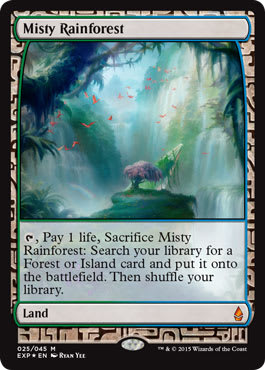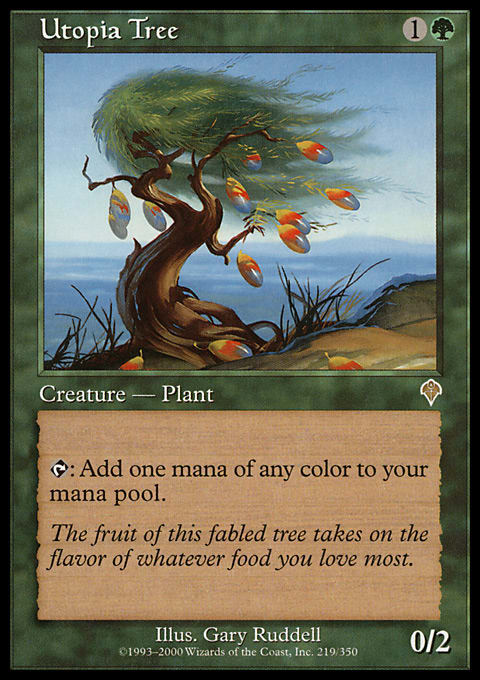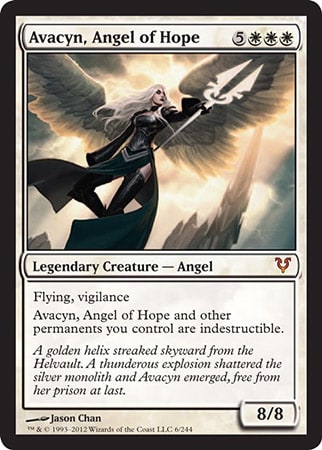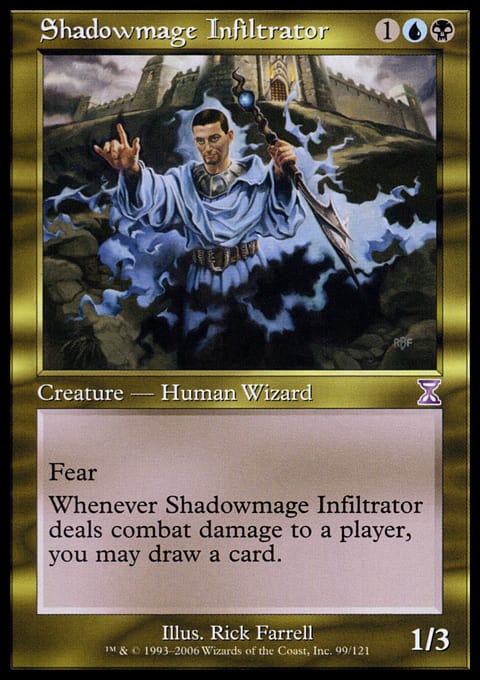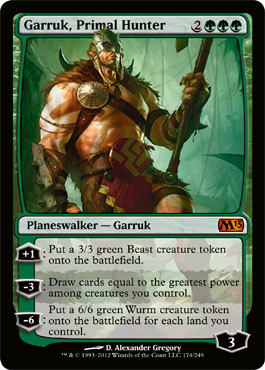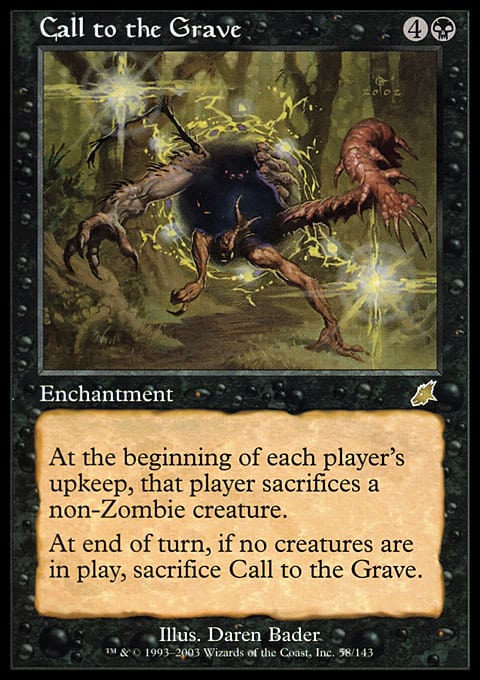(Note that prices can change, not only from the writing of this article, but also on its publication day—but the relative values expressed here remain.)
If you want to add creature-kill to your deck for Magic night, and you like Hero's Downfall because it can smash a planeswalker, too, is it worth the cost to upgrade from your Murder? The added flexibility takes a $.50 card and changes it to a very expensive Standard staple clocking in at $19 as of the writing of this article. Is the increased flexibility worth the price tag that comes with it?
Do you want Juzam Djinn for your deck? Perhaps Plague Sliver is good enough!
What is the cost-versus-value ratio of these cards?
Other examples might include mana creatures, such as Utopia Tree versus Sylvan Caryatid or Opaline Unicorn versus Alloy Myr—or removal, such as Natural End versus Krosan Grip and perhaps Crib Swap versus Swords to Plowshares. It can even include beaters, such as Darksteel Colossus versus Ulamog, the Infinite Gyre (or versus Blightsteel Colossus).
For many cards in Magic, there is a cost-versus-value ratio that must be considered when playing and acquiring cards. When one card costs a lot more than another, is the cost-versus-value ratio worth it?
Obviously, this answer will be somewhat dependent on who is asking the question. Everybody has different financial situations. Someone who has no children and a higher salary might be fine with the added price tag in most situations. On the other hand, another person with more debt, lower finances, a large family, or a smaller Magic budget might have a more limited design on picking up new cards. For them, the Terramorphic Expanse or Murder is the better pickup.
And of course, all of this has to be salted to your own individual collection. If you draft frequently and already own a play set of Hero's Downfall, you can add them without touching your bottom line. If you picked up fetch lands back when they were $10 a pop, you might have an extensive collection without breaking the bank, and thus, you can play them regularly. I’ve been playing Magic long enough that cards I picked up a long time ago are now worth massively more. For example, I once bought a player’s set of Bazaar of Baghdad for $120. Now just one of those cards is worth more than twice as much as I paid for all four. So, when I play a Bazaar in one of my Commander decks, people often think I spent a lot of money on it, but I actually didn’t. Everyone is in a different situation.
And yet, we all have to face a cost-versus-value question at some point in our playing career. Is the benefit I receive from a given card worth the additional price it will cost me in order to acquire it. This is a game, and the cards are just pieces therein. Is that game piece powerful enough to swing the game so much in my favor that the dollar signs are worth it?
I’ve been writing a lot about budgets and cheap cards for a little more than a year now because I have been unemployed. Therefore, budget decks and budget cards have been really interesting. You’ve seen a lot of budget decks clocking in under $10 a deck and budget Commander decks arriving at a sub-$40 level. I also have an article series in which I suggest cheap cards worth a buck or less that have a lot of redemptive value. Because I’ve been trying to get the best bang for my buck, I have been giving pointers in my articles.
You can play Magic cheaply if you want. You don’t need $5 spells that counter stuff—you can find cheap ones that are just as useful. The same is true of quality defense, land-fetching, burn, powerful creatures, utility creatures, mana rocks, and more. You can find great options in the budget section of a card store.
Now, to be fair, some cards are so unique that if you want the effect, you are forced to pay for the card. For example, if you want a land that will tap for a mana for each creature you control, you have to run Gaea's Cradle. You have to play Avacyn, Angel of Hope if you want a big beater to give everything you control indestructible. Cards like Maze of Ith (protecting without the use of mana), Volrath's Stronghold, Eternal Witness, Griselbrand, Skullclamp, and Emrakul, the Aeons Torn all qualify. So, sure, you sometimes have to pay to play.
And sometimes, the price difference is worth it. For example, take Recollect. It costs just 1 more mana than Regrowth for the same card. But Regrowth is a surprisingly cheap $1.50 right now. So, the upgrade from Recollect might be worth it to most people. That’s not a bad deal to have the best card.
Another example is Fact or Fiction. Right now, you can pick up the uncommon copy from Invasion for just $2, and you can pick up Steam Augury from Theros for $1.50. Steam Augury requires two colors, and the effect is worse, by far, than Fact or Fiction’s. Since it is the better card, and just $0.50 more than Steam Augury, Fact or Fiction can come in as a doable upgrade for many.
Finding these small prices that come with large improvements is really enjoyable. In my Dimir deck, is the upgrade from Shadowmage Infiltrator to Lu Xun, Scholar General worth the $2 in price difference? Lu Xun costs 4 mana to Shadowmage’s 3, but it is essentially unblockable. Is that worth the increase in cost from $2 to $4? Plus, like Fact or Fiction, Lu Xun is just in one color, increasing its flexibility for card stock. Some might think it the better card, and worth the extra cash, since it’s harder to block.
The red Akroma, Angel of Fury is pretty good, and it clocks in at $3.50. While she was great initially upon release, she is now about par on ability with a lot of recently-printed Dragons. You can find cheaper options that are almost as good.
The same is true of many other cards. While some of the great casual Equipment all-stars can be a bit too pricey for most, solid budget options abound. With the recent reprint in Commander (2013 Edition), Swiftfoot Boots is down to less than half the price tag of Lightning Greaves. And it’s just about as good. Hexproof is better than shroud, but the difference in equip cost can make an impact on the table. Each has something to recommend, and both have roughly the same play value. Some prefer one to the other, but money speaks a universal language.
Some of the best casual Equipment is cheap and can be used instead of the handful of expensive Equipment whose prices were inflated by tournament play. Some are cheap and powerful—such as Nim Deathmantle. Others are subtle and even cheaper, such as Strider Harness. There are a lot of great options for Equipment in your deck.
We even have some seriously cheap planeswalkers these days. Planeswalkers such as Garruk, Primal Hunter and Chandra, the Firebrand might not be the best in their colors, but they are good enough. Sorin, Lord of Innistrad may not make as many tokens as quickly as other planeswalkers, but he is super-cheap to pick up after his Duel Decks appearance. The same is true of cards such as Garruk Relentless.
And that’s not all. I mentioned burn before. Sure, you might think that a blowout card like Bonfire of the Damned or even something like Aurelia's Fury can just devastate another player’s board position. And you’d be right. Both are great cards that can do some nasty damage. But a simple Comet Storm costs one-fourth the price of a Bonfire (compare $1.50 to $6) and half that of a Fury (compare to $3 for a Fury). The Comet Storm may be just as good. And you might find spells such as Fanning the Flames to be a better choice than the Damned for your money. After all, it’s just a quarter.
Some of the cheapest cards are quality defensive agents. Seraph of the Sword and Commander Eesha are both great flyers that can stick through multiple combats and that will set you back very little money. It may be better to rely on some of these cards than the expensive Kor Haven, which is now in the $8 range. That thing just keeps creeping up little by little. Even a pimped-out Legends copy of a Horn of Deafening costs just $2, and a white-bordered Chronicles copy is just $0.50. Plus, the Horn is slightly better since you can use it to prevent combat damage that a blocker would deal—rather than just an attacker.
While you can build around The Abyss with creatures that cannot be targeted or with artifact dorks, it’s still basically just a pricey Call to the Grave. You can build around the Call with Zombies, but for most situations, the cards are identical save that the Call costs 5 mana. But the difference in price is incredible.
People have already talked about the fixed Doubling Season with Primal Vigor. Right now, the Vigor is clocking in at $7, and that’s a sharp sight less than the daddy of Doubling Season. Sure the, Season is better, but is it $10 better? Don’t forget Parallel Lives either.
The point of all of this discussion is to look at the cost versus the value of a card from a variety of angles. Not only have I given you a lot of examples to consider, but I also want to raise the question generally. What impact does this have on your collection, card acquisition, and deck construction? What are some other examples of cards for which the better card is worth more than the lesser but not enough for you to make the purchase?
See you next week,
Abe Sargent
















